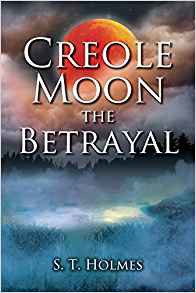Title: Creole Moon the Betrayal
Author: S. T. Holmes
Publisher: Toplink Publishing
ISBN: 978-1947620070
Pages: 204
Genre: Fiction / Fantasy / Horror
Reviewed by: Joe Kilgore
Pacific Book Review
The state of Louisiana and its most famous city, New Orleans, has been the chosen locale for many gothic novels and tales of the supernatural. The city’s rich cultural heritage and its historic mix of races have provided a wealth of fodder for tales both historic and horrific. Author S. T. Holmes employs both of those qualities in this involving tale of obsession, possession, witchcraft, and voodoo in his fantasy horror novel Creole Moon the Betrayal.
The story begins in the 1800’s, prior to the Civil War. Readers are immediately introduced to two brothers, one of whom is about to be married. As they celebrate the impending nuptial, it becomes apparent the non-fiancé, a dashing young military man, is to be the primary protagonist. While he wishes his brother well, he makes it quite clear that marriage is not for him. Individuality and personal freedom are what he holds dearest and he has no plans to give up either.
Soon however, the young man is seemingly overtaken by some supernatural force and he is immediately smitten with a lovely young woman. Unfortunately for him, the girl harbors rabid anti-slavery feelings and has a dangerous habit of voicing her decidedly unpopular opinions in public. This will soon lead to extremely unpleasant predicaments for both.
Without giving away too much of the plot, which unfolds in rather surprising ways, the hero soon gets involved with a local witch doctor known as The Chicken Man. Not only is he a practitioner of the black arts, so is his wife. They take on major roles as the narrative begins to morph from historic fiction to horror story. Before you know it, our young hero is involved with demigods, Gods, and all manner of strange goings-on, both natural and unnatural. Violent storms, pale moons, lightening and thunder, share space with spells, curses, potions, transformations, magic, mayhem and more.
The author spins this yarn sequentially, which keeps the pace moving along rapidly. Third person omnipotent perspective is used effectively, except when the author occasionally lapses into inserting contemporary idioms into the thoughts and dialogue of these nineteenth century characters. Late in the novel, the timeframe changes and the story is moved a hundred years forward. Then frankly, it ends rather abruptly—leading one to assume there must be more to come in subsequent volumes of strange happenings under the Creole Moon.



Follow Us